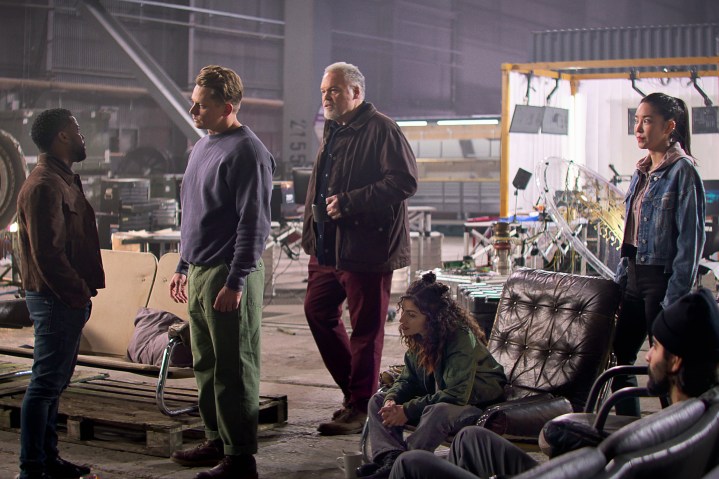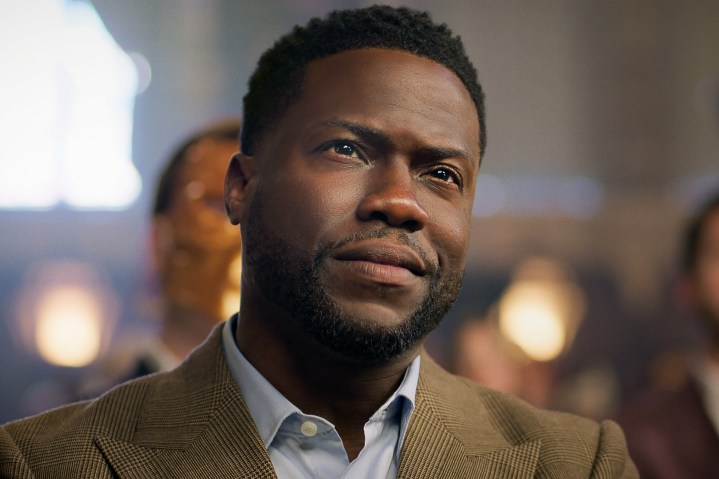
“Lift is a star-studded heist thriller that lacks both the precision and artistry necessary to achieve all of its admirable goals.”
Pros
- A star-studded cast of immensely charismatic actors
- A fun last-minute twist
Cons
- A visually unpleasant, cheap aesthetic
- A forced, underbaked romantic subplot between its leads
- A third act that asks you to suspend your disbelief far too often
Lift has a lot going for it. The new Kevin Hart-led heist thriller has, for starters, an impressive, charming cast of capable performers, all of whom seem genuinely thrilled to be a part of it. The film also exists in a subgenre that, perhaps more than any other, is associated with easy, relaxed entertainment, which helps casts it in an even more endearing light. But whether they’re directed by Steven Soderbergh or, in the case of Lift, F. Gary Gray, the one thing that heist thrillers need to be is cinematic, and that’s something that Netflix’s latest feature production decidedly isn’t.
There’s an unfinished quality that hangs over all of Lift. The film feels as if it was cobbled together in a mad rush — its exterior scenes are all seemingly lit the same way and its editing alternately seems purposefully convoluted and chaotic. The likability of its cast prevents it from ever becoming too dreary of an affair, but it never wins you over, either. The film seems immediately destined, like so many other Netflix originals, to become a forgotten title in all of its players’ respective filmographies.

Lift is simultaneously an ensemble thriller and a new star vehicle for its lead, Kevin Hart. The popular comedian-turned-actor stars in the film as Cyrus Whitaker, a master art thief who is constantly pursued by Abby Gladwell (Gugu Mbatha-Raw), a determined Interpol agent who shared a brief fling with him a year before Lift begins. The film follows Cyrus as he’s asked by Abby to help Interpol take down Lars Jorgensen (Jean Reno), a powerful investment banker who secretly funds terrorist attacks that he then uses to manipulate the world’s stock markets in his favor. In exchange, Cyrus and his team of fellow thieves will receive full legal immunity for all of their past crimes.
Taking down Jorgensen won’t be easy, though. Abby, Cyrus, and his crew will have to work together to not only steal $500 million worth of gold bars from the formidable, internationally known criminal, but they’ll also have to do it without alerting him to the theft until it’s too late. To do so, they’ll have to steal the gold bars while they are being transported across Europe on a plane without landing it. It’s a fittingly over-the-top heist for a film as pulpy as Lift, and it opens the door for plenty of cinematic, eye-popping set pieces and stunts.
Unfortunately, Lift never fulfills the promise of its potential. The film’s heist, which is set mostly in two planes and an air traffic control tower, is hampered by the blandness of its sets and the inexplicable emptiness of its central passenger aircraft. The CGI used to bring its exterior aerial shots to life isn’t as egregious as modern viewers have gotten used to, but it also makes it that much more difficult for Lift’s climax to sell its purportedly life-and-death stakes. The film is further hindered by the ham-fisted nature of Daniel Kunka’s screenplay, which comes up with increasingly unbelievable ways to keep its characters stuck on a path that they should be able to easily divert from.

Gray is no stranger to big-budget action films or heist thrillers. The director’s previous credits include everything from Friday and Set it Off to The Italian Job and Straight Outta Compton, but the technical craftsmanship of many of his past films is absent from Lift. The movie looks visually flat and unintentionally overexposed, which wipes away the intended sexiness of its crime plot and sanitizes an already underbaked romantic storyline between Hart’s Cyrus and Mbatha-Raw’s Abby. The latter feels uniquely indebted to a similar subplot between Brad Pitt and Catherine Zeta-Jones in 2004’s Ocean’s Twelve, but Lift’s low-grade TV aesthetic robs it of the cinematic sensuality that globe-trotting romantic crime capers like it require.
What makes that particular flaw all the more frustrating is the amount of money that was clearly, visibly spent on Lift. The film features a number of stunning real-life locations, and its scope feels appropriately massive. The fact that the film has the wisdom not to fake its European cities and villages, but lacks the technical precision necessary to make them shine is partly what makes it such a strange movie. It has all the ingredients it needs to be a breezy, memorable heist comedy, but it doesn’t know how to bring them together. The film similarly doesn’t know how to fully utilize its cast, which counts scene-stealing actors like Echo‘s Vincent D’Onofrio, Billy Magnussen, Úrsula Corberó, and Yun Jee Kim among its supporting performers.

D’Onofrio delightfully chews up the scenery as Denton, a master of disguise, and both Magnussen and Corberó also stand out as two other members of Cyrus’ crew. Opposite them, however, Hart isn’t entirely convincing as a flirtatious, Danny Ocean-esque leading man, and he seems to be constantly muting his own innate charisma in favor of embracing a stiffer, less natural persona. It’s not hard to picture him successfully leading a film like Lift again in the future, but only if he doesn’t try to shy further away from the comedic energy that made him a star in the first place. It’s easy to see what he’s going for here, but his performance just doesn’t come together enough to really work.
The same can be said for Lift itself, a film that has all it needs to succeed. For a thriller that spends the majority of its third act in the air, though, Lift struggles to ever get off the ground.
Lift premieres Friday, January 12 on Netflix.
Editors’ Recommendations

